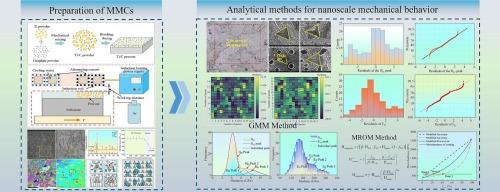基于多尺度纳米压痕和GMM的mmc力学性能评价——以感应包覆原位TiC/Ti涂层为例
IF 7.9
2区 材料科学
Q1 MATERIALS SCIENCE, MULTIDISCIPLINARY
引用次数: 0
摘要
多尺度增强相的不均匀空间分布和尺寸效应给金属基复合材料表面力学性能的表征和分析带来了挑战。因此,本研究提出了一种结合高斯混合模型(GMM)的多尺度杂化纳米压痕测试策略来评估原位感应包覆TiC/Ti多相复合涂层的表面力学性能。涂层由α-Ti、少量β-Ti和弥散分布的TiC增强相组成。显微硬度稳定在~ 600 HV0.2, TiC相表现出“浅硬-深软”的行为。TiC区域内的力学性能(WTR)介于TiC和基体相之间,β-Ti基体相表现出优于α-Ti的性能。采用改进的混合规则(ROM)方法建立了显微硬度与单纳米压痕硬度的相关模型,揭示了TiC体积分数增加时相结构的演变规律。基于gmm的纳米压痕数据解耦表明,硬度和弹性模量服从三峰高斯分布,分别对应TiC相、WTR相和基体相。该研究为mmc性能的优化提供了理论基础。本文章由计算机程序翻译,如有差异,请以英文原文为准。

Mechanical properties evaluation of MMCs via multi-scale nanoindentation and GMM: A case study on induction-cladded in-situ TiC/Ti coatings
The inhomogeneous spatial distribution and size effect of multi-scale reinforced phases makes it challenging to characterize and analyze the surface mechanical properties of metal matrix composites (MMCs). Therefore, a multi-scale hybrid nanoindentation testing strategy integrated with the Gaussian mixture model (GMM) was developed to evaluate the surface mechanical properties of induction-cladded in-situ TiC/Ti multi-phase composite coating in this study. The coating consisted of α-Ti, a small amount of β-Ti and a diffusely distributed TiC reinforced phase. The microhardness stabilized at ∼ 600 HV0.2, and the TiC phase exhibited a “shallow hard − deep soft” behavior. The mechanical properties of within the TiC region (WTR) were between those of TiC and the matrix phase, and the β-Ti matrix phase exhibited superior performance to that of α-Ti. A correlation model between microhardness and single nanoindentation hardness was constructed using the modified rule of mixtures (ROM) method, revealing the evolution of the phase structure with an increase in the TiC volume fraction. GMM-based decoupling of nanoindentation data indicated that hardness and elastic modulus followed a three-peak Gaussian distribution, corresponding to TiC, WTR, and matrix phases. This study provides a theoretical foundation for the optimization of MMCs properties.
求助全文
通过发布文献求助,成功后即可免费获取论文全文。
去求助
来源期刊

Materials & Design
Engineering-Mechanical Engineering
CiteScore
14.30
自引率
7.10%
发文量
1028
审稿时长
85 days
期刊介绍:
Materials and Design is a multi-disciplinary journal that publishes original research reports, review articles, and express communications. The journal focuses on studying the structure and properties of inorganic and organic materials, advancements in synthesis, processing, characterization, and testing, the design of materials and engineering systems, and their applications in technology. It aims to bring together various aspects of materials science, engineering, physics, and chemistry.
The journal explores themes ranging from materials to design and aims to reveal the connections between natural and artificial materials, as well as experiment and modeling. Manuscripts submitted to Materials and Design should contain elements of discovery and surprise, as they often contribute new insights into the architecture and function of matter.
 求助内容:
求助内容: 应助结果提醒方式:
应助结果提醒方式:


